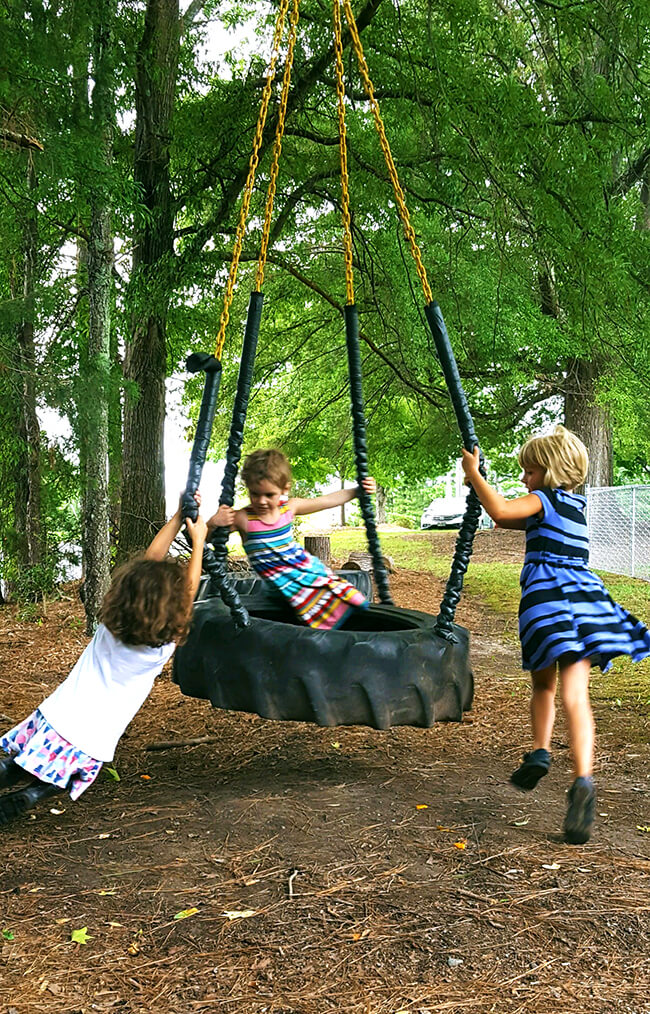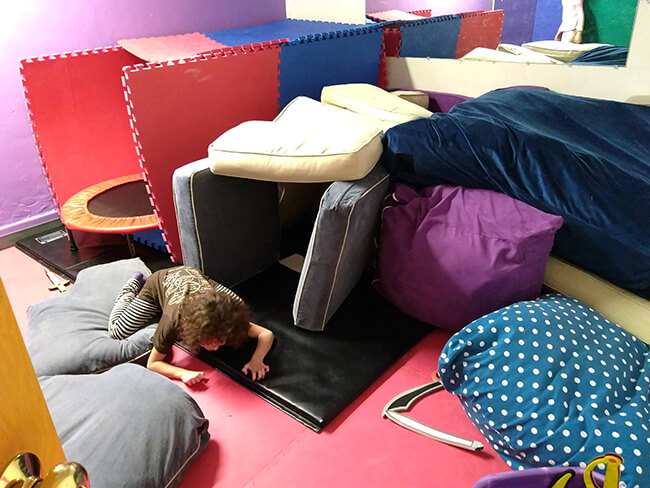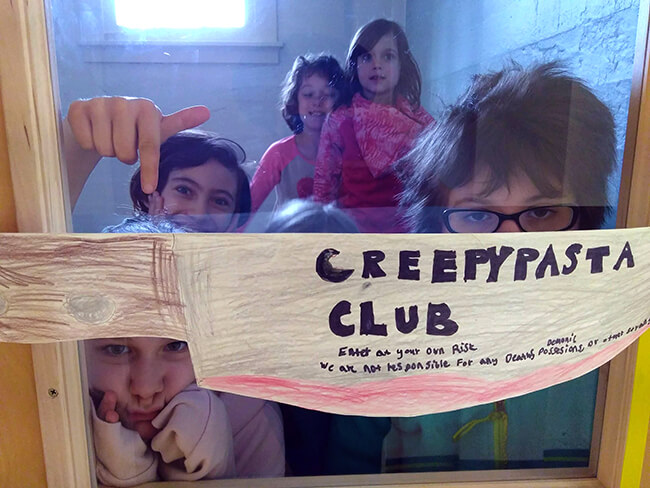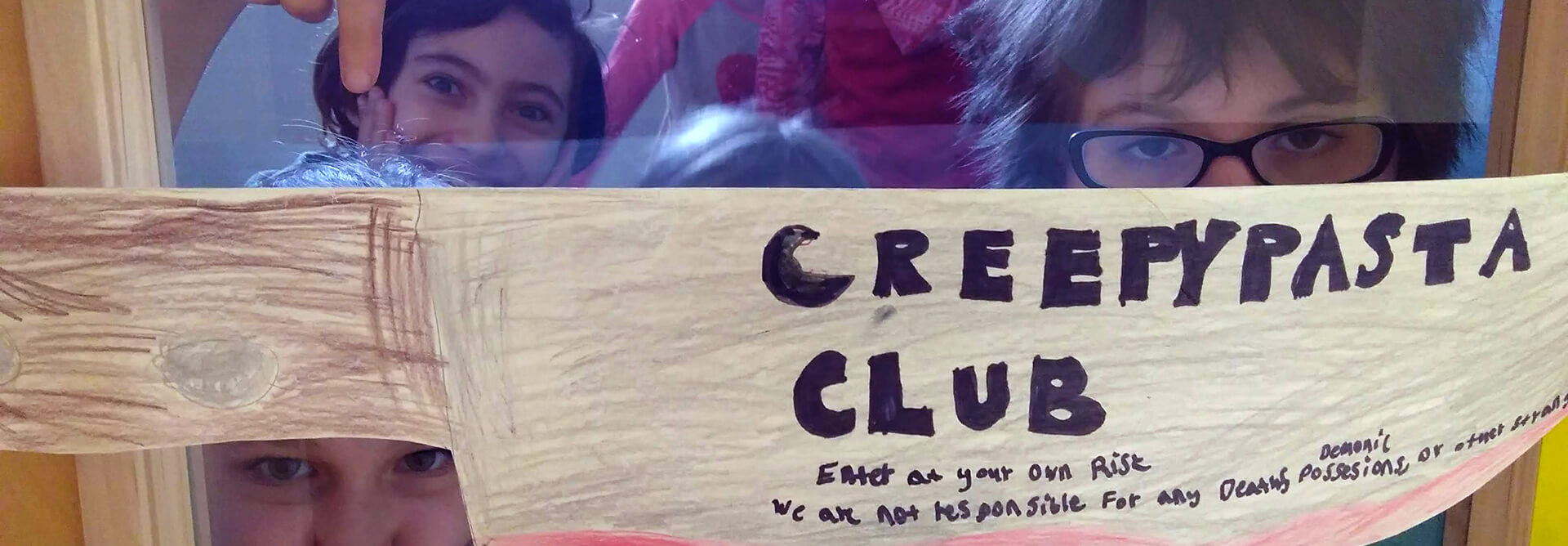
“I’m scared!”, Sam says. His tone of voice is tremulous as he plays with his friend Becca on the tire swing. He looks terrified.
“Let’s make it go ALL the way up!” Becca says, wanting to wind the swing all the way, until it can’t be wound any further.
Sam reluctantly agrees and Becca helps Sam wind the swing “ALL the way up.” As the swing unwinds, there are squeals of exhilaration mixed with just the right amount of terror. Over and over again they wind it up and let it unwind, screaming. Sam and Becca laugh, and Sam no longer seems scared, but proud.
At Pathfinder Community School – a self-directed learning center in Durham, NC, the outdoor tire swing gets a lot of use. Kids can often be seen winding up the swing, climbing on, and spinning as the swing unwinds.
What Sam and Becca did was just part of a normal day for self-directed learners. They all seem to be seeking the perfect edge- a place of the exact right amount of fear. Getting hurt, of course, is too much. But feeling the terror and surviving leads to a glow of exhilaration- the feeling of, “I did it!”
In our increasingly-safe modern world, we tend to treat fear or a sense of danger as something a child should not experience. Of course, there is some valuable wisdom in that, and we’d be the last to tell anyone that danger is a categorically good thing. And yet, in shielding children from their feelings as well as actual existential threats, we are teaching them the world is a dangerous place. A low-lurking sense of anxiety is likely much more harmful in the long run than a quick dose of fear.
Learning to cope with fear can educate us about things like our own limits and how to cope with challenge.
Take the case of Sam and the swing. Sam has seen other kids wind up the swing and spin around as it unwinds at a frenzied pace. He wonders if he can do that, but when he imagines himself there, he is scared. He’s never gone that fast before. Can I do it?
Childhood is a time when we develop a sense for how the world works. But part of doing that is developing a sense of how we work and how we relate to the world. What can we do in the world? What possibilities are open (and closed) to us? When Sam feels fear by imagining himself whirling on that swing, he is preparing himself for scary situations he may encounter in his life, and is practicing managing to stay in difficult situations. According to research professor in psychology, Dr. Peter Gray, this is an essential skill.
In risky play, youngsters dose themselves with manageable quantities of fear and practice keeping their heads and behaving adaptively while experiencing that fear. They learn that they can manage their fear, overcome it, and come out alive. In rough and tumble play they may also experience anger, as one player may accidentally hurt another. But to continue playing, to continue the fun, they must overcome that anger. If they lash out, the play is over...
Children know how to dose themselves with just the right amount of fear, for them, and for that knowledge to operate they must be in charge of their own play.1
It’s hard to cope with risks in a safety-oriented culture. As people helping self-directed learners, we could have dealt with the issue of risky play by systematically eliminating risks. When I think about modern American parenting, safety culture, and the risk of lawsuits damaging our program, I become afraid to let the kids take chances. But the more I see kids learning to self-regulate their fear and aggression, the more I come to the conclusion that it is the most important thing they could possibly be doing.
Pillow Fights as Anger Management

If the tire swing is Fear Management 101, then our Rumpus Room provides the place for Anger Management: Advanced Course.
It was our spring pilot kids who asked for foam swords, and pillows for pillow fights. Now it’s almost a rite of passage for kids who are new here: breaking down in tears in the Rumpus Room. I’ve gotten really good at distinguishing between “happy screams” and “painful screams for help.”
The other week, I was asked to mediate a conflict between two Pathfinder kids, let’s call them Leo and John. “John, I see you are upset. Did you want Leo to stop hitting you?”
“No! I WANTED him to hit me! Just not that hard,” said John.
“Okay, let’s make a safe pillow in the corner,” said Leo. “Go stand on that purple pillow if you want a time out.”
As soon as they understood each other clearly, the play began again.
What I saw that day, and have seen over and over again, is that allowed to find their natural boundaries through free play, kids will negotiate to find a way to continue playing together that works for everyone. They don’t want the fun game to stop. But in that process, they feel real, genuine anger while waving a pretend sword. The adrenaline rises as they rush, push, and parry blows. The game can go from exhilarating fun to “too much” in seconds, and as the kids spend more time roughhousing, they get better and better at communicating clearly and directly to each other when it’s too much. The kids also get better at self-regulating and dialing back when someone asks them to.
If these kids can practice self-control in the mayhem of a pillow fight, what can’t they do? I can’t help but think we may be raising some amazing future negotiators and diplomats.
Taking it to the teen level
Most people I talk to can see how pillow fights and tire swinging can be beneficial to children. They’re glad to see the physical activity, and most adults don’t have much emotional baggage about tire swings. But once we bring in teenagers, the activities and topics that create actual fear and anger for them get a lot more culturally taboo, fast.
Teens have an amazing ability to zero in on what makes adults most uncomfortable. All the same, I see teens exploring the world and their place in it, and managing their feelings of fear about things that are legitimately scary, controversial, or uncomfortable for most adults—whether it’s profanity, sexuality, taboo topics such as suicide, or graphic violence in the form of horror memes. It’s very difficult for me personally to stand by and allow people to “self-direct” in these uncomfortable taboo directions, and I’m sure many parents of teens and unschoolers alike will agree. At the same time, I see grappling with these real-world issues as one of the most important parts of Self-Directed Education.

The Pandora’s Box that is the internet reflects back a warped side of ourselves that many people might choose not to look at. Recently our kids have taken interest in “Creepypasta,” online memes that elicit horror. Kids talk in whispers about hauntings, demonic possessions, and other paranormal activities. Some of the kids in the community recoil in fear, yet are drawn inexorably back into the orbit of spookiness. Strategies for ghost-friending, ghost-busting, ghost origin stories and folklore about ghost protection are shared as matters of great import. The books about ghosts and other paranormal activities are in heavy use in the library.
Parents *hate* Creepypasta Club. They complain to me about their kids having nightmares. But when I ask the teens and tweens why this is important to them, the maturity with which the group responds is simply astounding.
“I like talking to people who share my love of thrillers and the horror genre. I feel like I can be myself here and make new friends.”
“I like to research demonology. It’s a very interesting subject I found out about when I was doing history research.”
“I see it as an outlet for strong feelings I have. I know the difference between a game and real life. I’m not going to hurt anyone and I even know spells to keep people safe.”
“It makes me feel special, excited, kind of scared, but fun- scared, not scared-scared.”
I can remember that feeling from childhood sleepovers—I have clear memories of staying up too late, saying all the words I wasn’t “supposed” to say. Giggling in the bathroom, taking turns turning the lights off and talking to Bloody Mary...becoming terrified when I was convinced I felt a cold presence. I remember the rush of excitement—just the right level of “fun-scared,” and how it felt like maybe magic was real, and anything could be possible, and maybe I was the character in a story, a thrilling page-turner.
Remembering the times I was seeking that “thrilled” feeling helped me to move past my own fears, the fear that parents would get upset when they heard their kids were conducting seances during “school” hours!
THE ONLY THING TO FEAR IS....
To help me with my fear of parental reprisals, we conducted conversations in our Parent Circle using the same process that we use with the kids, sociocracy. It is important for me to know how the parents feel so I have a clear channel of communication with them about sensitive topics that come up with the kids. Parents shared their fears about how people handle internet filtering and “inappropriate” content. Mostly it seems, we were afraid of having to talk to children about pornography, or have them exposed to graphic video game violence. But when one parent who was born in Eastern Europe spoke, I felt like someone had splashed me with water in the face.
“We are so privileged,” she said. “We live in a peaceful time in a wealthy country. None of our children have to deal with famine, rapes, or massacres in their daily lives. In another time or another place, we wouldn’t have the luxury to shield them from these horrors.”
We looked at one another soberly. Somehow protecting the kids from creepy memes or phantom online predators seemed like a menace that was all in our heads. Are we finding imaginary tigers in the shadows to protect our children from, forgetting that they are, statistically speaking, safer than anyone has ever been in the history of humanity?
Maybe it’s time that as adults, we honestly confront our own fears. The deep, dark ones, the ones that we project onto our children and young people in our lives. How can we talk to children about managing their fears in a healthy way when we haven’t learned to manage our own fears...about them?
[1] Gray Ph.D., Peter. “Risky Play: Why Children Need It.” https://www.psychologytoday.com/us/blog/freedom-learn/201404/risky-play-why-children-love-it-and-need-it. Accessed June 20, 2019.
If you enjoyed this article and feel called to give back to ASDE, here are ways you can support our work:
- Donate money
- Share our content with others! Click one of the buttons above to easily share on Twitter, Facebook, or email.
- Consider becoming a Contributor for Tipping Points
Tipping Points Magazine amplifies the diverse voices within the Self-Directed Education movement. The views expressed in our content belong solely to the author(s). The Alliance for Self-Directed Education disclaims responsibility for any interpretation or application of the information provided. Engage in dialogue by reaching out to the author(s) directly.






